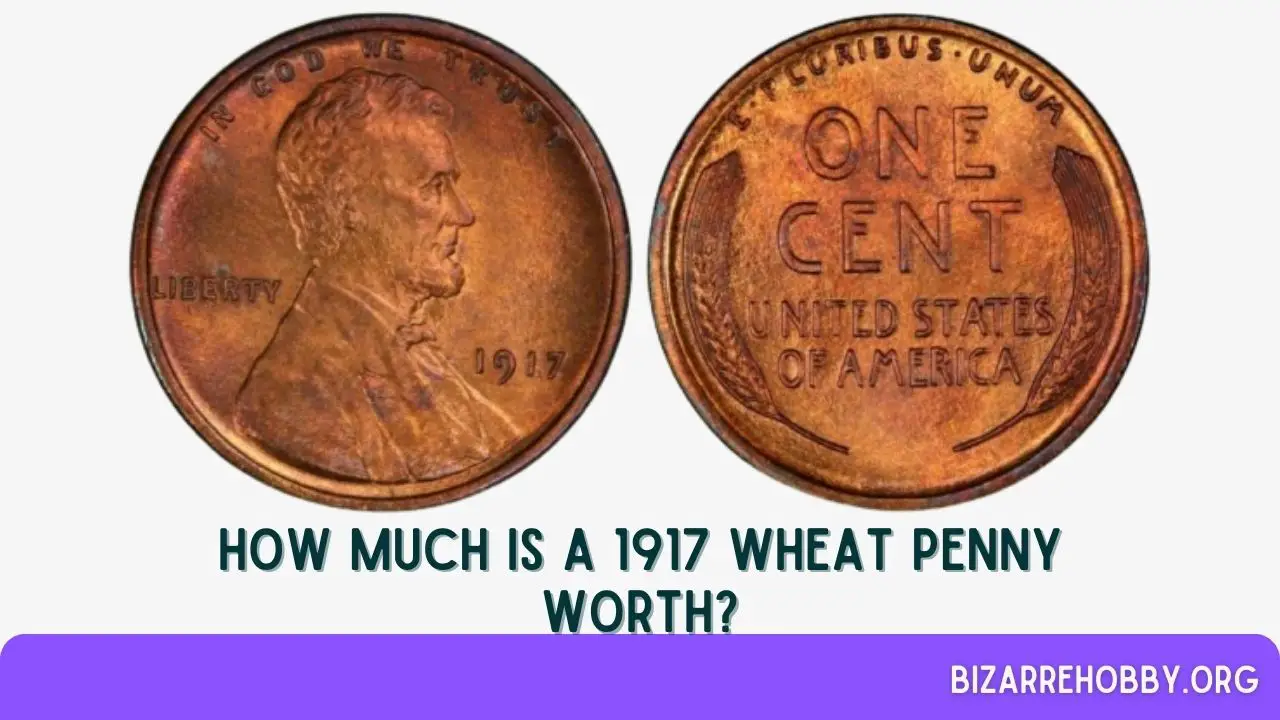The 1917 Wheat Penny, a cherished piece of American numismatic history, often holds a value exceeding its face value. While these coins are generally more common and affordable than some might expect, they remain a significant part of the Lincoln Wheat Penny series minted from 1909 to 1958, making them a favorite among collectors.
Table of Contents
- Value Chart for 1917 Wheat penny
- Historical Background of the 1917 Wheat Penny
- Types Of 1917 Wheat Penny
- Design of the 1917 Wheat Penny
- 1917 Wheat Penny Grading Guide
- 1917 Wheat Penny Value Guides
- Rare 1917 Wheat Penny Error List
- Where to Sell Your 1917 Wheat Penny?
- What to look for in the 1917 Wheat Penny?
- Which 1926 Wheat Penny is Worth a lot of Money?
- FAQs On 1917 Wheat Penny Value
- Final Thoughts
Value Chart for 1917 Wheat penny
| Condition | 1917 No Mint Mark Penny | 1917 DDO Penny | 1917 D Penny | 1917 S Penny |
|---|---|---|---|---|
| Good | $0.50 | $160 | $2.25 | $2.50 |
| Very good | $0.75 | $260 | $5 | $5 |
| Fine | $1.50 | $315 | $8.50 | $8 |
| Very fine | $5 | $550 | $17.50 | $12.50 |
| Extra fine | $10 | $1,400 | $40 | $25 |
| AU | $15 | $1,600 | $47.50 | $32.50 |
| MS 60 | $31 | $3,750 | $90 | $100 |
| MS 63 | $55 | $8,150 | $150 | $200 |
Historical Background of the 1917 Wheat Penny
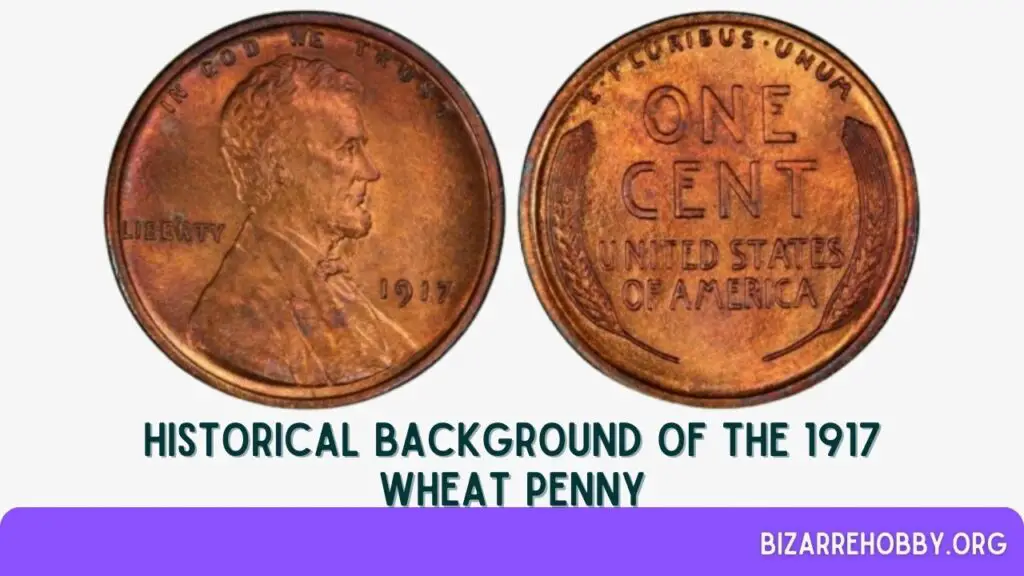
The Lincoln Wheat Penny is widely regarded as one of the most influential coins ever produced by the US Mint. This series, which commemorates President Abraham Lincoln, began in 1909 and has a rich history.
The 1917 pennies are consistent with the design introduced in 1910, except for the 1909 issues that featured the designer Victor David Brenner’s initials, VDB, on the obverse. Another notable variation includes pennies made from recycled shell casings during World War II.
The redesign of these coins, which eventually led to the introduction of the Lincoln Memorial on the reverse and later a shield, marked the end of an era. Despite these changes, the Wheat Penny remains a beloved symbol of American coinage.
Types Of 1917 Wheat Penny
| Mint | Year | Mintage |
|---|---|---|
| Philadelphia | 1917 no mint mark penny | 196,429,785 |
| San Francisco | 1917 S penny | 32,620,000 |
| Denver | 1917 D penny | 55,120,000 |
| Total | NA | 284,169,785 |
Design of the 1917 Wheat Penny
The 1917 Wheat Penny, designed by Victor David Brenner, shares its design with other coins from the early 20th century but can vary significantly in value based on its condition and mint mark.
Obverse Design of 1917 Wheat Penny

The obverse of the 1917 Wheat Penny features:
- A portrait of Abraham Lincoln
- The date “1917”
- The word “LIBERTY”
- The motto “IN GOD WE TRUST”
- A mint mark (“D” for Denver, “S” for San Francisco, or no mark for Philadelphia)
Reverse Design of 1917 Wheat Penny
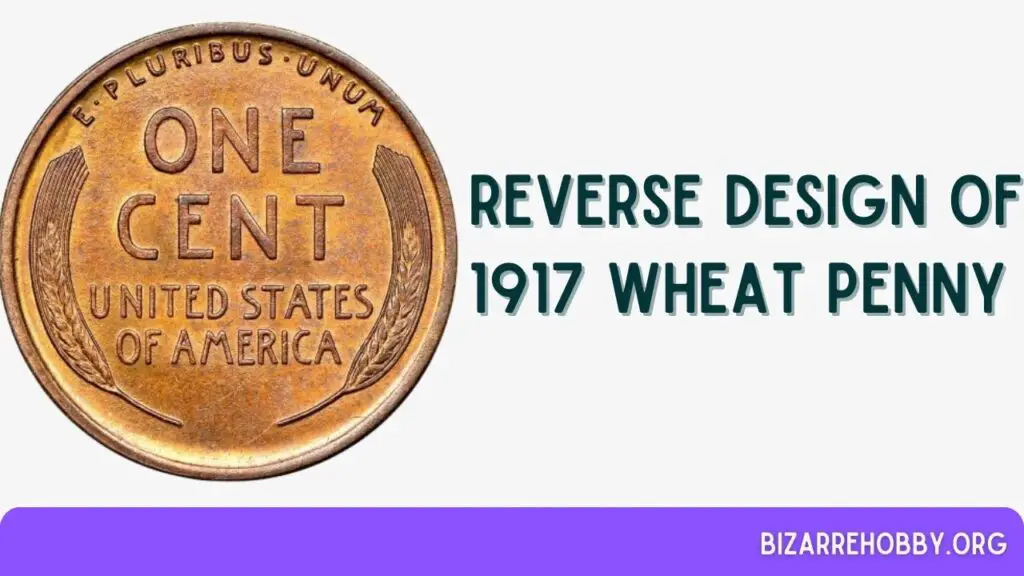
The reverse side includes:
- The inscription “UNITED STATES OF AMERICA”
- Two wheat ears flanking the denomination
- The denomination “ONE CENT”
- The motto “E PLURIBUS UNUM”
Technical Specifications Of 1917 Wheat Penny
| Face Value | One cent ($0.01) |
| Shape | Round |
| Coin Thickness | 1.52 millimeters (0.0598 inches) |
| Coin Weight | 0.11 ounces (3.11 grams) |
| Edge | Smooth (plain) |
| Coin Diameter | 19.05 millimeters (1.75 inches) |
| Compound | An alloy of 95% copper with zinc or tin |
1917 Wheat Penny Grading Guide
Determining the value of a 1917 Wheat Penny involves assessing its condition and identifying any errors. Well-preserved coins, especially those with rare errors, can be quite valuable. It is advisable to have an expert grade your coin to ascertain its true worth.
| Sheldon Scale | Grade |
|---|---|
| 1 | Basal State-1 |
| 2 | Fair |
| 3 | Very Fair |
| 4, 5, 6 | Good |
| 7, 8, 10 | Very Good |
| 12, 15 | Fine |
| 20, 30 | Very Fine |
| 40 | Extremely Fine |
| 50 | About Uncirculated |
| 60 | Mint State |
| 65 | Mint State |
| 70 | Mint State |
For a detailed guide on grading Lincoln Wheat Pennies, refer to our comprehensive grading resources to accurately determine your coin’s value.
1917 Wheat Penny Value Guides
In 1917, the total mintage across three mints reached 284,169,785 coins. However, not all of these pennies have survived to the present day, especially those in top condition, which are now considered rare gems in the market.
1917 No Mint Mark Wheat penny Value

The Philadelphia Mint produced the majority of 1917 Wheat pennies, with a total of 196,429,785 coins. These coins can be categorized into three main groups based on their desirability and collectibility.
- Brown-Toned Coins: These are the least sought after by collectors. Circulated brown-toned pennies from 1917 typically range in value from $0.20 to $14.40, depending on their condition. Even uncirculated brown-toned coins are relatively affordable, with prices ranging from $13 to $144. Exceptionally, a 1917 MS 66 brown penny fetched $1,125 at auction in 2021.
- Red-Brown Pennies: These are more desirable than brown-toned coins. In mint state (MS 63 to MS 66), their value ranges from $55 to $360. A notable sale includes a 1917 MS 66 RB penny, which sold for $1,293 in 2013.
- Red Pennies: These are the most collectible due to their high luster and attractive red color. Prices for lower-ranked pieces (MS 63) range from $110 to $132. Higher grades command significantly higher prices:
- MS 64: $190 to $228
- MS 65: $360 to $432
- MS 66: $950 to $1,200
- MS 67: $3,700 to $4,400
- MS 68: $44,000 to $60,000
The highest auction record for a 1917 MS 68 red Wheat penny is $38,813, achieved in 2006.
1917 D Wheat penny Value
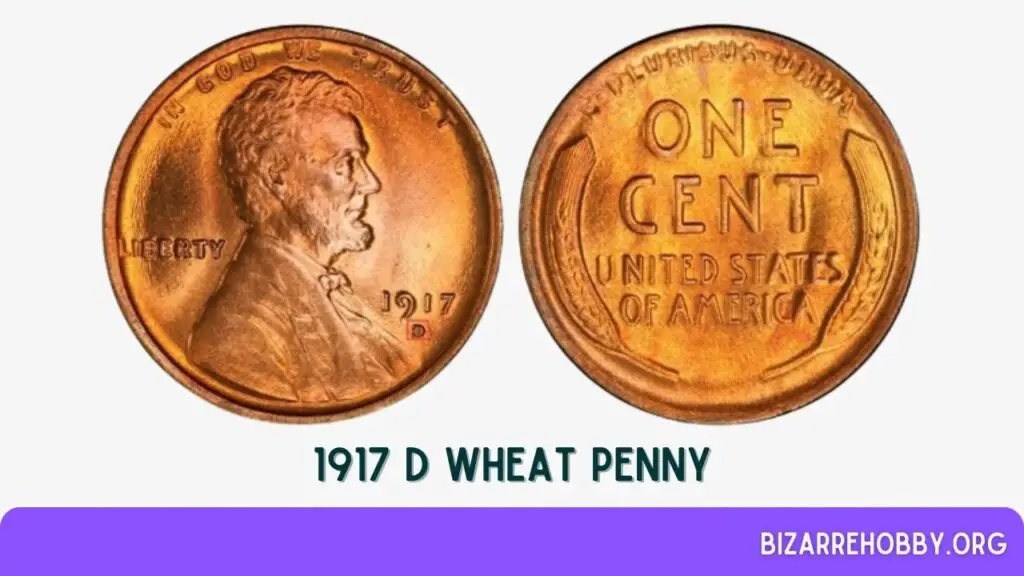
The Denver Mint produced 55,120,000 Wheat pennies in 1917, the second-highest mintage for that year.
- Brown Coins: Circulated brown coins with the “D” mint mark typically range from $0.50 to $57.60. Uncirculated coins are valued higher, from $90 to $500 for MS 60 to MS 65 grades. An MS 66 brown penny set an auction record of $1,725 in 2010.
- Red-Brown Pennies: These are more valuable, with prices ranging from:
- MS 63: $165 to $198
- MS 64: $360 to $432
- MS 65: $575 to $690
- MS 66: $1,900 to $2,400
A red-brown penny in MS 66 sold for $3,600 in 2021.
- Red Pennies: These are the most prized. Estimated values are:
- MS 63: $300 to $360
- MS 64: $450 to $540
- MS 65: $1,200 to $1,440
- MS 66: $7,000 to $8,400
A 1917 red Wheat penny in MS 66 fetched an impressive $21,275 at auction in 2005.
1917 S Wheat penny Value
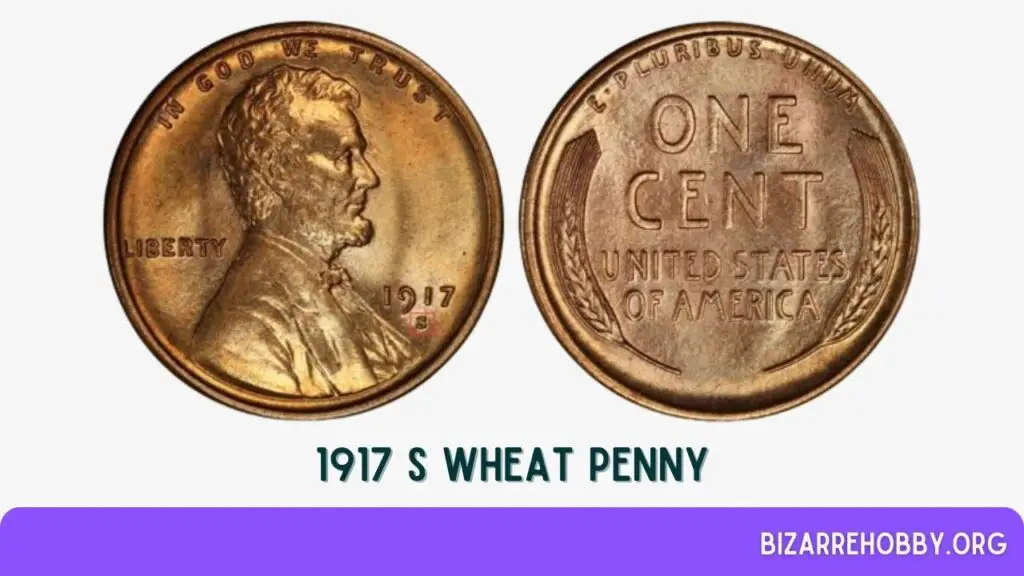
The San Francisco Mint had the lowest mintage in 1917, producing 32,620,000 pennies. Despite this, these coins are still relatively abundant, especially in lower grades.
- Brown Coins: Circulated brown pennies range from $0.35 to $54. Uncirculated brown coins are valued between $60 and $550. An MS 66+ brown penny set an auction record of $8,225 in 2018.
- Red-Brown Pennies: These coins are more valuable, with prices ranging from $160 to $1,000. An MS 66 red-brown penny reached $3,850 at auction in 2013.
- Red Pennies: These are the most valuable, with estimated prices as follows:
- MS 63: $600 to $720
- MS 64: $1,200 to $1,440
- MS 65: $8,500 to $15,000
- MS 66: $34,000 to $60,000
The highest auction record for a 1917 S MS 65 red Wheat penny is $36,800, achieved in 2007.
Rare 1917 Wheat Penny Error List
The 1917 Wheat Penny series, like many other coin sets, includes numerous coins with striking errors due to human mistakes or malfunctioning machinery. Among these, one error stands out for its rarity and value.
1917 Wheat Penny DDO Error
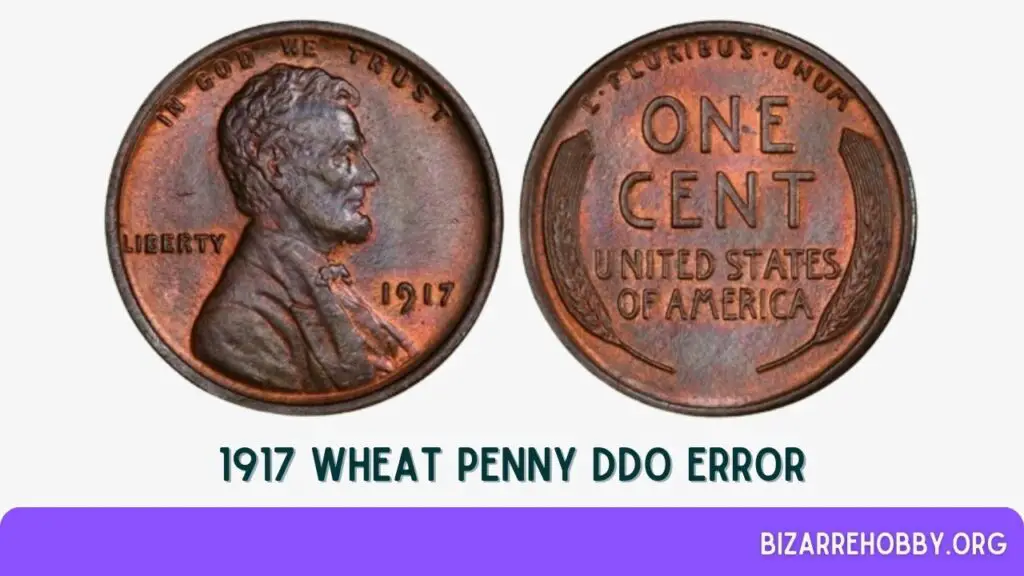
The 1917 Double Die Obverse (DDO) pennies are highly sought after by collectors due to their rarity and unique appearance. These coins can command high prices, even in circulated condition, ranging from $100 to $2,640. In mint state, their value increases significantly, with prices between $2,750 and $7,200.
- Red-Brown Coins: These coins are particularly valuable, with prices ranging from $6,500 to $10,500 for grades MS 63 to MS 65.
- Red Coins: The most prized are the red-toned cents, with estimated values as follows:
- MS 63: $8,000 to $9,600
- MS 64: $10,500 to $12,600
- MS 65: $15,000 to $18,000
- MS 66: $25,000 to $30,000
- MS 67: $85,000 to $100,000
The highest auction record for a 1917 MS 67+ red penny with a DDO error is $120,000, achieved in 2019, making it the most valuable coin in this series.
Other 1917 penny errors
In addition to the famous DDO error, several other notable errors can be found in the 1917 Wheat Penny series:
- Die Crack (Die Cud) Errors: These coins can range in value from $3 to $150.
- Off-Center Errors: These typically sell for $10 to $20.
- Re-Punched Mint Mark Errors: These are valued between $5 and $20.
- Reverse Struck-Through Errors: These can fetch between $10 and $100.
Where to Sell Your 1917 Wheat Penny?
Knowing the value of your 1917 Wheat Penny is just the first step. Selling these coins online can be straightforward if you know where to look. Here are some recommended platforms:
- eBay: A popular marketplace with a large audience, but be mindful of fees.
- Heritage Auctions: Ideal for high-value coins, offering professional auction services.
- Coin Dealers: Local coin shops can provide immediate sales but may offer lower prices.
What to look for in the 1917 Wheat Penny?
When evaluating a 1917 Wheat Penny, several key factors can significantly influence its value and desirability among collectors:
1. Mint Mark
- No Mint Mark: Indicates the coin was minted in Philadelphia.
- “D” Mint Mark: Indicates the coin was minted in Denver.
- “S” Mint Mark: Indicates the coin was minted in San Francisco.
2. Condition and Grade
- Circulated vs. Uncirculated: Uncirculated coins are generally more valuable.
- Color: Coins are categorized as brown, red-brown, or red, with red being the most valuable due to its luster and eye appeal.
- Grade: Higher grades (MS 63 and above) command higher prices. Look for coins graded by reputable services like PCGS or NGC.
3. Errors and Varieties
- Double Die Obverse (DDO): This error significantly increases a coin’s value. Look for doubling in the date and lettering.
- Die Cracks and Cuds: These can add value, especially if they are prominent.
- Off-Center Strikes: Coins with noticeable off-center strikes are rare and valuable.
- Re-Punched Mint Marks: These errors can also add to the coin’s value.
4. Historical Context
- Rarity: Coins from the San Francisco mint are generally rarer.
- Historical Significance: Coins minted during significant historical periods, like World War I, can be more desirable.
By paying attention to these factors, you can better assess the value and collectibility of a 1917 Wheat Penny.
Which 1926 Wheat Penny is Worth a lot of Money?
- The 1917 MS 67+ red Wheat DDO penny holds the record at $120,000 (2019).
- The 1917 MS 67 red Wheat DDO penny sold for $84,000 (2018).
- The 1917 MS 68 red Wheat penny fetched $38,813 (2006).
- The 1917 S MS 65 red Wheat penny reached $36,800 (2007).
- The 1917 D MS 66 red Wheat penny was auctioned for $21,275 (2005).
FAQs On 1917 Wheat Penny Value
What makes a 1917 Wheat Penny Rare?
While many 1917 pennies are common, rare errors and high-grade red specimens, especially those from the San Francisco mint, can be extremely valuable, sometimes exceeding $100,000.
How much is the 1917 Wheat Penny worth?
The value of a 1917 Wheat Penny can vary significantly based on its color and condition. For brown-toned pennies, circulated examples typically range from $0.20 to $14.40, while uncirculated ones can fetch between $13 and $144. Red-brown pennies are generally valued higher, with prices ranging from $30 to $360. The most valuable are the red-toned pennies, which can be worth between $110 and $4,400. In exceptional cases, such as those graded MS 68, these red pennies can command prices between $44,000 and $60,000.
What is the costliest Lincoln penny?
When it comes to the costliest Lincoln pennies, the 1943 D MS 64 brown (bronze) penny holds the record with a value of $840,000. Another highly valuable penny is the 1909 VDB PR 67+ proof penny, which is priced at $258,500. Other notable sales include the 1943 S MS 63 brown (bronze) penny at $504,000, the 1944 S MS 66 (steel) penny at $408,000, the 1958 MS 64 red DDO penny at $336,000, and the 1944 MS 64 (steel) penny at $180,000.
Final Thoughts
The 1917 Wheat Penny is a fascinating piece of American numismatic history. Whether you are a seasoned collector or a novice, understanding the nuances of these coins can enhance your appreciation and potentially your investment.
From mint marks and errors to the coin’s condition and historical context, each aspect plays a crucial role in determining its value. Always consider getting your coins graded by a professional service to ensure their authenticity and condition.
